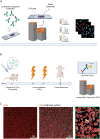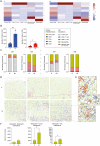Neutrophils seeking new neighbors: radiotherapy affects the cellular framework and the spatial organization in a murine breast cancer model
- PMID: 38430241
- PMCID: PMC10908631
- DOI: 10.1007/s00262-024-03653-1
Neutrophils seeking new neighbors: radiotherapy affects the cellular framework and the spatial organization in a murine breast cancer model
Abstract
Neutrophils are known to contribute in many aspects of tumor progression and metastasis. The presence of neutrophils or neutrophil-derived mediators in the tumor microenvironment has been associated with poor prognosis in several types of solid tumors. However, the effects of classical cancer treatments such as radiation therapy on neutrophils are poorly understood. Furthermore, the cellular composition and distribution of immune cells in the tumor is of increasing interest in cancer research and new imaging technologies allow to perform more complex spatial analyses within tumor tissues. Therefore, we aim to offer novel insight into intra-tumoral formation of cellular neighborhoods and communities in murine breast cancer. To address this question, we performed image mass cytometry on tumors of the TS/A breast cancer tumor model, performed spatial neighborhood analyses of the tumor microenvironment and quantified neutrophil-extracellular trap degradation products in serum of the mice. We show that irradiation with 2 × 8 Gy significantly alters the cellular composition and spatial organization in the tumor, especially regarding neutrophils and other cells of the myeloid lineage. Locally applied radiotherapy further affects neutrophils in a systemic manner by decreasing the serum neutrophil extracellular trap concentrations which correlates positively with survival. In addition, the intercellular cohesion is maintained due to radiotherapy as shown by E-Cadherin expression. Radiotherapy, therefore, might affect the epithelial-mesenchymal plasticity in tumors and thus prevent metastasis. Our findings underscore the growing importance of the spatial organization of the tumor microenvironment, particularly with respect to radiotherapy, and provide insight into potential mechanisms by which radiotherapy affects epithelial-mesenchymal plasticity and tumor metastasis.
Keywords: Cancer; Cellular neighborhood; Image mass cytometry; Neutrophil; Radiotherapy.
© 2024. The Author(s).
Conflict of interest statement
The authors, whose names are listed immediately below, certify that they have no affiliation with or involvement in any organization or entity that has a financial or nonfinancial interest in the topics or materials discussed in this manuscript.
Figures




Similar articles
-
A novel tumor-immune microenvironment (TIME)-on-Chip mimics three dimensional neutrophil-tumor dynamics and neutrophil extracellular traps (NETs)-mediated collective tumor invasion.Biofabrication. 2021 Apr 8;13(3):10.1088/1758-5090/abe1cf. doi: 10.1088/1758-5090/abe1cf. Biofabrication. 2021. PMID: 33524968 Free PMC article.
-
Cathepsin C promotes breast cancer lung metastasis by modulating neutrophil infiltration and neutrophil extracellular trap formation.Cancer Cell. 2021 Mar 8;39(3):423-437.e7. doi: 10.1016/j.ccell.2020.12.012. Epub 2021 Jan 14. Cancer Cell. 2021. PMID: 33450198
-
The Emerging Role of Neutrophil Extracellular Traps (NETs) in Tumor Progression and Metastasis.Front Immunol. 2020 Sep 16;11:1749. doi: 10.3389/fimmu.2020.01749. eCollection 2020. Front Immunol. 2020. PMID: 33042107 Free PMC article. Review.
-
Targeting Neutrophil Extracellular Traps: A Novel Antitumor Strategy.J Immunol Res. 2023 Nov 9;2023:5599660. doi: 10.1155/2023/5599660. eCollection 2023. J Immunol Res. 2023. PMID: 38023616 Free PMC article. Review.
-
Neutrophils drive accelerated tumor progression in the collagen-dense mammary tumor microenvironment.Breast Cancer Res. 2016 May 11;18(1):49. doi: 10.1186/s13058-016-0703-7. Breast Cancer Res. 2016. PMID: 27169366 Free PMC article.
Cited by
-
Effect of neutrophils on tumor immunity and immunotherapy resistance with underlying mechanisms.Cancer Commun (Lond). 2025 Jan;45(1):15-42. doi: 10.1002/cac2.12613. Epub 2024 Nov 1. Cancer Commun (Lond). 2025. PMID: 39485719 Free PMC article. Review.
-
The untapped potential of radiation and immunotherapy for hormone receptor-positive breast cancer.NPJ Breast Cancer. 2025 Jul 24;11(1):77. doi: 10.1038/s41523-025-00796-x. NPJ Breast Cancer. 2025. PMID: 40707495 Free PMC article. Review.
-
Neutrophils as key regulators of tumor microenvironment in breast cancer: a focus on N1 and N2 polarization.Ann Med Surg (Lond). 2025 Apr 10;87(6):3509-3522. doi: 10.1097/MS9.0000000000003269. eCollection 2025 Jun. Ann Med Surg (Lond). 2025. PMID: 40486595 Free PMC article. Review.
References
-
- WHO (2021) Breast cancer. [Web Page] 2021 26.03.2021 [cited 2023 26.01.2023]; Facts Article on Breast Cancer]. Available from: https://www.who.int/news-room/fact-sheets/detail/breast-cancer
MeSH terms
Grants and funding
LinkOut - more resources
Full Text Sources
Medical
Research Materials

